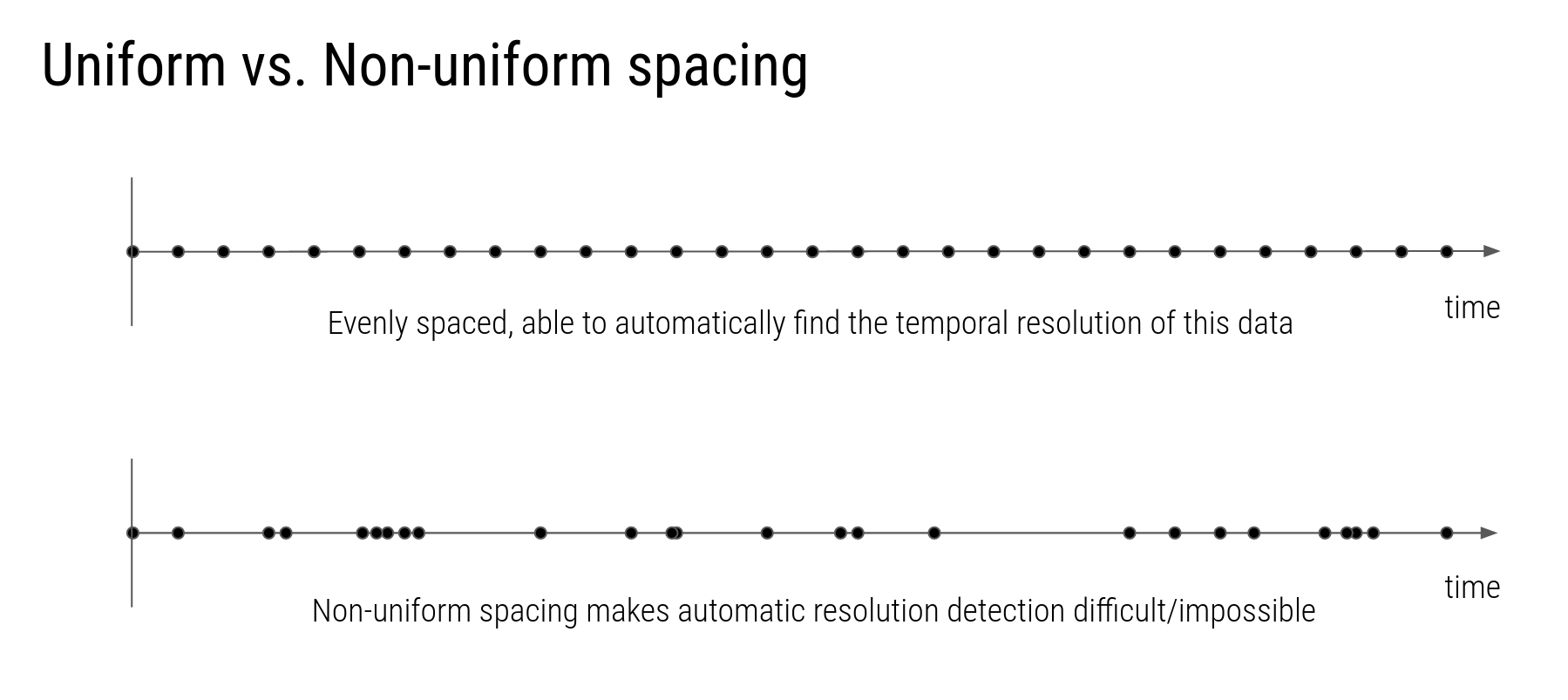Temporal Resolution
One of Cartwright’s capabilities is to predict the temporal resolution of a given feature column. For example, if you have a column of dates, Cartwright can tell you whether the dates are in days, months, or years, as well as identify if there are any gaps or irregularities in the data.
Temporal resolution detection is a sub-problem in the larger problem of dataset alignment: given two datasets with possibly different temporal resolutions, how can we align them so that they can be compared? Cartwright’s temporal resolution detection is a first step in this process.
Detection Process
Given data at evenly spaced time intervals, the resolution can be automatically detected. A simple heuristic is used to perform the analysis:
- convert all unique dates/times to unix timestamps
- sort the timestamps and compute the delta time between each
- find the median of the deltas
- characterize the uniformity of the deltas
- find the closest matching time unit from a preset list
- convert the median delta to a proportion of the matched unit, and set as the temporal unit for the dataset
Usage
Let’s say we have a CSV with the following data in it:
date,temperature(C)
2019-01-01 00:00:00, 10.2
2019-01-01 02:00:00, 11.7
2019-01-01 04:00:00, 12.3
...
2019-12-31 22:00:00, 10.1
We can automatically detect the frequency of measurements
from cartwright.analysis.time_resolution import convert_to_timestamps, detect_temporal_resolution
import pandas as pd
# Load the data
df = pd.read_csv("path/to/data.csv")
# convert the dates to timestamps
timestamps = convert_to_timestamps(df["date"].to_list(), '%Y-%m-%d %H:%M:%S')
# detect the temporal resolution
resolution = detect_temporal_resolution(timestamps)
The resulting object will contain the following results:
Resolution(
uniformity=Uniformity.PERFECT,
unit=TimeUnit.HOUR,
resolution=2.0,
error=0.0,
)
indicating that the dataset has a resolution of 2 hours.
Resolution Results
Time resolutions are represented by a Resolution object with values:
uniformity: (enum) Measures how uniform the time intervals are (see below).unit: (enum) The unit of time (e.g. hour, day, week, etc)resolution: (float) A multiplier on the unit, e.g. 2 hours, 3 days, etc.error: (float) The mean error of the time intervals from the expected value.
If the detection process fails, the object will be None
In addition to detecting data precisely matching known units, such as hours, days, years, etc. Cartwright can also detect data at fractional units, such as 6 hours, 3.5 days, 1.25 years, etc. In these cases, unit will be set to the closest matching unit, and resolution will be set to the fractional amount of that unit.
Uniformity
Uniformity captures whether temporal resolution is a coherent property for the given feature.

Depending on the application, some slight level of non-uniformity may be acceptable. Cartwright classifies temporal uniformity as one of three categories:
UNIFORM: all values spacings fall within1e-9the average spacingUNIFORM: all values are within1%of the average spacingNOT_UNIFORM: any values fall outside of the above criteria
For most applications, PERFECTLY_UNIFORM and UNIFORM are good enough. And in fact, for some units of time, PERFECTLY_UNIFORM may not occur at all. E.g. years may contain leap days which then cause that columns to be identified as UNIFORM, even if the values are perfectly uniform. Similar effects happen dues to daylight savings time, etc.
Units of Time
Cartwright supports the following units of time:
millisecond(1e-3 * second)second(1)minute(60 * second)hour(60 * minute)day(24 * hour)week(7 * day)year(365 * day)month(year / 12)decade(10 * year + 2 * day)century(100 * year + 24 * day)millennium(1000 * year + 242 * day)
In the future, temporal units will be drawn from a more comprehensive units ontology
Currently milliseconds may experience issues due to floating point precision errors, and thus may not be detected by this process.